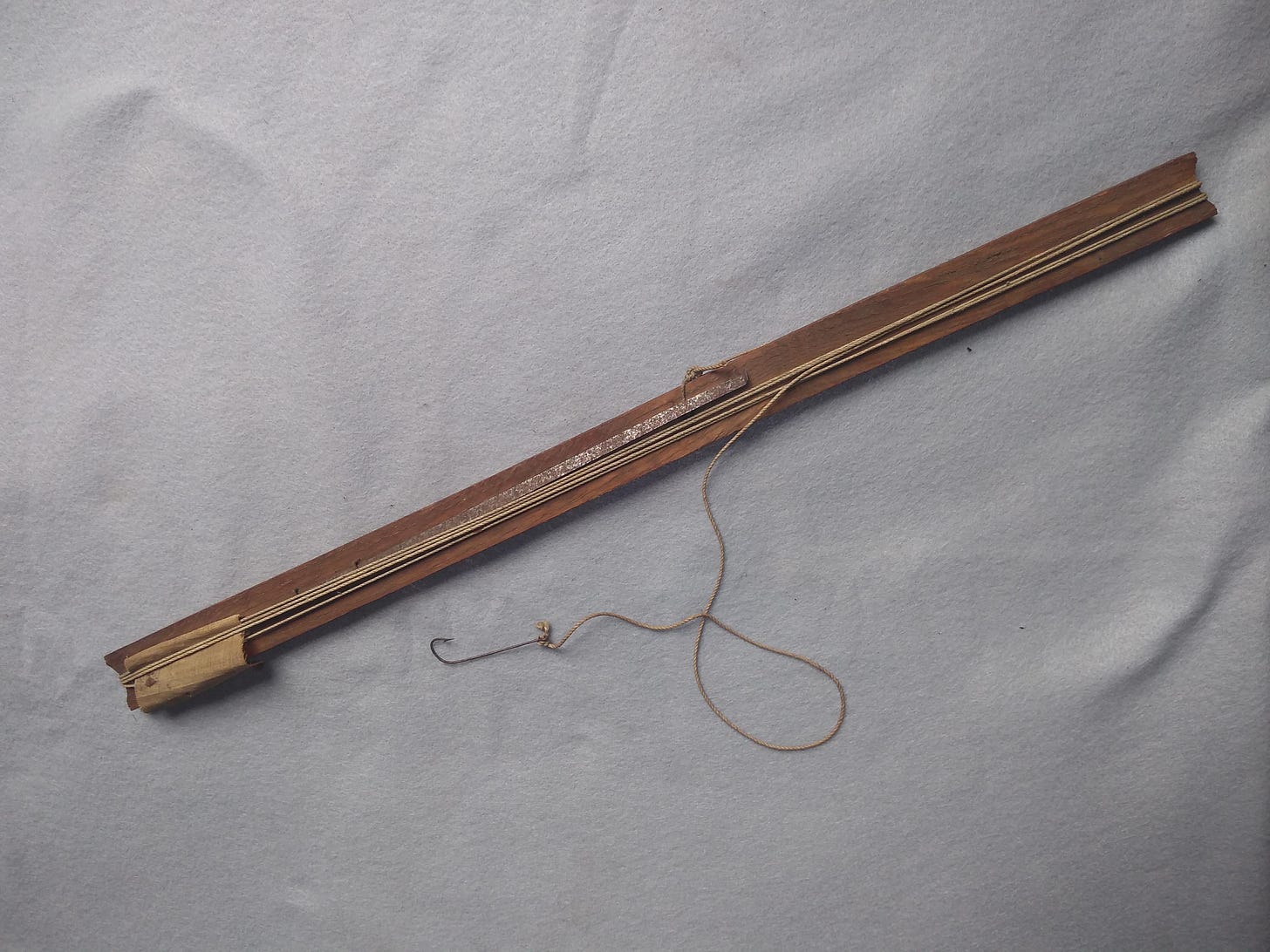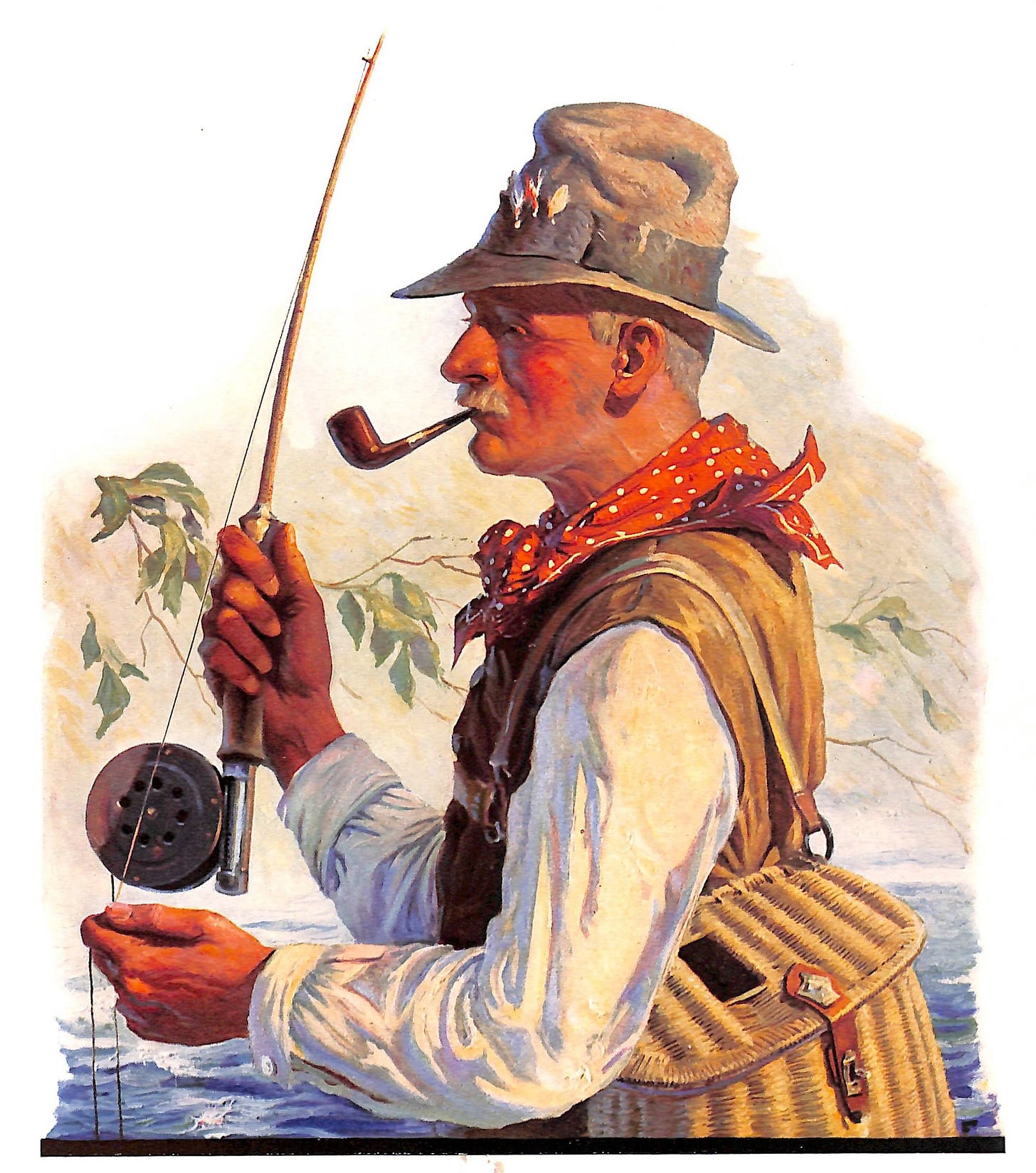What’s It Wednesday - The Art of Angling
You know the old saying - “Give a man a fish and he will eat for a day. Teach a man how to fish and you feed him for a lifetime.” Here’s what’s needed.
Fishing as a means of gathering food goes back thousands of years. Recent analysis of the bones of Tianyuan 1 found in southeast Asia dated to 40,000 years ago and indicated that freshwater fish were a main part of the diet.
4,000-8,000 years ago, Ancient Egyptians used nets, spears, hooks, and poles to fish in the Nile.
Evidence exists that Ancient Chinese, Greeks, Assyrians, and Native Americans all fished as a major source of food.
A hook and line, maybe a float and rod, were all that were needed.
When fishing changed from a source of food to more of a recreational activity isn’t historically clear.
The earliest appearance of fishing as a pastime appears in an essay, Treayse of Fysshynge with an Angle, in the second edition of the Boke of Saint Albans. The book, published in 1496, is credited as written by Dame Juliana Berners, the prioress of the Priory of St. Mary of Sopwell of St. Albans, in Hertfordshire, England. (Angle comes from the Old English word, angol, meaning hook.)
The Boke of Saint Albans includes information for ‘proper gentlemen’ on hunting, hawking, heraldry, and the art of angling. It includes the location of the best fishing areas, information about making rods and lines, as well as ‘etiquette for the angler.’ During the 1500s, it was the guide and reprinted numerous times.
Then came Izaak Walton and The Compleat Angler.
Walton’s book helped to popularize fishing as a recreational activity. Izaak Walton (1593 to 1683) remains famous today as the author of the most important environmental book in history. He celebrated fishing, particularly fly fishing, as a way to be ‘one with nature.’ He introduced the idea of sustainability and respect of the natural world. The book ends with Walton’s caution to “Study to be quiet.”
Robert Venable (ca. 1613–1687 published The Experienc’d Angler in 1662, with a preface by Izaac Walton.
The frontispiece image is one of the earliest published images of what was once considered necessary fishing equipment. A creel.
A creel is a woven basket that fishermen, on a riverbank or wading in the water, would use to hold fish that they caught. The word creel can be traced to Middle English 1250-1450 C.E. Usually woven of willow, a fisherman would line the creel with leaves or moss. Dipped in the cold water, the moss and leaves would stay moist and help keep the fish fresh.
The shape of a creel hasn’t changed much through the years. Creels are somewhat curved in the back and bulbous in the front, with a hinged lid. The rectangular hole provides additional air flow and allows a fisherman to slide fish easily into the creel without having to open the lid. The shape of the creel and positioning on the hip, allows for undisturbed casting.
By the 1700s, fishing rods and techniques became much more sophisticated than a wooden pole, line and hook. Rings along the rods were added which gave an angler more control over the line when casting. Jointed rods appeared in 1750s and bamboo was used for the top section of rods for flexibility. So popular was fishing that rods, hooks, bobbers, sinkers, and other fishing needs were sold in men’s clothing stores.
George W. Snyder (1780–1841) an inventor and watchmaker from Paris, Kentucky, invented the first American-designed fishing reel. Never patented, it was widely copied and quickly became mass-produced in factories throughout the Northeast. The factory-made Kentucky Reel, as it was called, was more affordable which spurred sales and added to the growing popularity of fishing to all levels of society.
Of course, Charles F. Orvis, of Vermont, became perhaps the most widely known pioneer in American fly-fishing. He opened a tackle shop in Manchester, Vermont in 1856. He designed a special reel for fly-fishing in 1874, which was considered the first modern fly reel. He also sold his fishing tackle through The Orvis Company catalogs prior to the Civil War, making The Orvis Company the oldest mail-order retail company in the U.S.
Fishing equipment itself hasn’t changed much since the early 1900s. As a recreational sport, fishing has had peaks and valleys. It peaked in the U.S. in the early 1920s and understandably fell during WWII. In the 1990s, it rose again, perhaps as an Oct 6, 2020, Wall Street Journal Magazine article indicated, “when images of a young Brad Pitt casting for Montana trout in A River Runs Through It sent droves of neophytes to their nearest Orvis dealer.”
Also, according to the article, since 2019, participation in fly-fishing has increased 3 percent a year. In the first 8 months of 2020, Connecticut sold 6 percent more fishing stamps required for the state licenses, and New York saw a 15 percent increase in fishing license purchases. More women are involved in fishing than ever before.
It is a great way to spend a hot, lazy day of summer. Go fishing!
Thanks for reading!
Please share your comments and memories. I admit that I am not proficient at fishing. It’s been years since I last fished. As a child in Maryland I went fishing a few times. Then it was more about catching crabs or catfish. Personally, I like catching crabs best.
I will be taking a few weeks off until September. Let’s just say “I’m going fishing!”
Marilyn Helmers
You can comment below or email me at mhelmers@andoverhistoryandculture.org
Click here to open a free Substack account, so you can like, share, and comment.
History Buzz is a reader-supported publication. To receive new posts and support our work, consider becoming a free or paid subscriber.
Resources
Andover Center for History and Culture Collections














This was an interesting post. Fishing is bad around here, no thanks to the drought. Have a good vacation, Marilyn
Have fun fishing, Marilyn! See you in September.